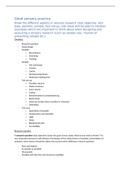Samenvatting
Summary Tutorials/E-modules of Principles of Sensory Science
Summary of the tutorials/E-modules of the course Principles of Sensory Science. Summary of the tutorials/E-modules: Good sensory practice, discrimination testing and signal detection theory and advanced topics. Summarized by learning outcome, with important concepts and definition in bold. Leavi...
[Meer zien]





